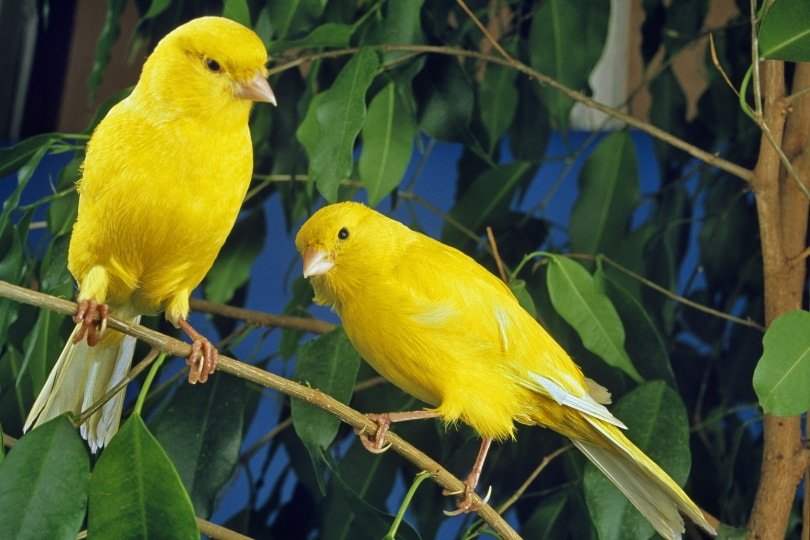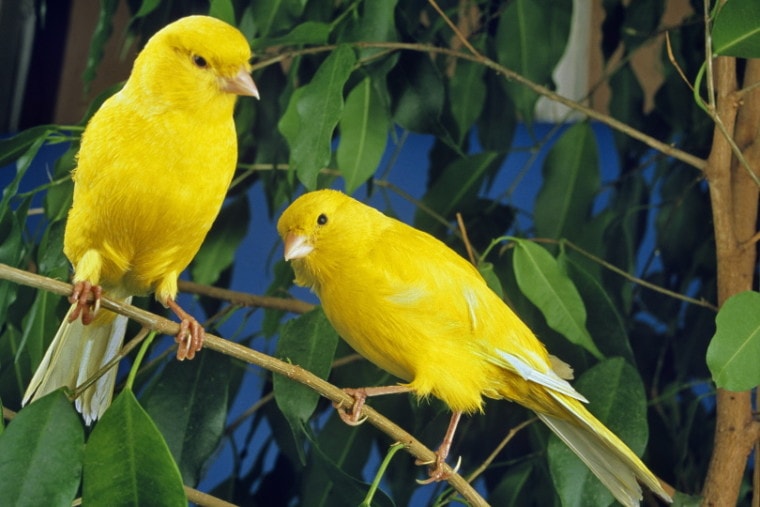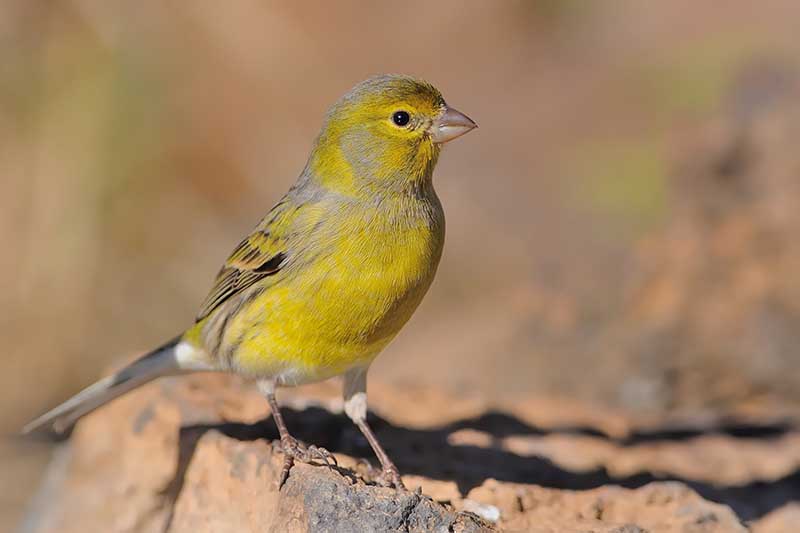
[ad_1]

There’s nothing quite like birdsong, and the American Singer Canary is said to be the most accomplished songbird in the US. The bird is a crossbreed of two species of Canaries and is one of the most beautiful and melodic competition birds that has graced homes throughout the country since its inception in 1930. Read on to discover how the gifted American Singer Canary came to be and how best to care for one.

Species Overview
| Common Names: | American Singer Canary, North American Canary, Water Canary |
| Scientific Name: | Serinus Canaria Domesticus |
| Adult Size: | 5.5″ |
| Life Expectancy: | 10-15 years |

Origin and History
The American Singer Canary was created by eight women in 1934 who lived in Milton, Massachusetts. They wanted to create the perfect Canary for the American home. The first American Singer was bred from two other Canary breeds known for their pretty looks and beautiful songs: the German roller and the English Border. American Singers were given the name after a Canary show in Boston, where the American Singers Club (which regulates the breed) was formed.
Four to 5 years of breeding is needed to create American Singer Canaries. By law, only Canaries specifically bred to the set guidelines and fitted with a registered leg band can be named American Singers.
The Canaries are domesticated from wild canaries. Canaries originate from the Macaronesian Islands; they were first bred in captivity in 17th-century Europe after Spanish traders brought them back overseas.
Their popularity as pets and workers grew worldwide; Canaries were even used in mines until 1986 in the UK, the US, and Canada. Canaries were used as early carbon monoxide detectors for the miners in mineshafts.
Temperament
American Singer Canaries are known to be humble and sweet. The males gain their beautiful voices when they reach maturity at around 6 months of age, and they often treat their owners to a song when they greet them. Females of the species do sing, but not to the extent that males do. American Singers do best when they’re kept in their cages, happy with members of their own species or on their own. They are jovial little birds who love watching the world go by, but they can be overshadowed by more brash bird species and become timid.
American Singers are intelligent enough to recognize their owners and perch on their fingers, but they generally don’t do well being handled outside their cage like some other small birds.
Speech & Vocalizations
American Singer Canaries don’t speak like other birds, but they can be taught to sing specific melodies by tutor birds. Tutor birds are other canaries that pass on songs from bird to bird (or generation to generation) by repeatedly playing the melody. The American Singer Canary is bred for singing and is considered to have the most beautiful song of all.
American Singer Canary Colors and Markings

American Singer Canaries come in many colors and markings and often display the classic yellow associated with the birds.
The most common variations in color and pattern are:

Caring for the American Singer Canary
American Singer Canaries are hardy birds that make popular pets for beginner bird owners. They like open spaces, so providing enough cage space with higher roosting spots is crucial to their health and happiness.
Providing it’s light and airy, cage bars should be around half an inch or less to stop your Canary from getting its head caught in them. American Singer Canaries can be acclimatized to outdoor aviary life, but they’re better indoors, away from draughts or direct sunlight.
Cage Furnishings
American Singer Canaries need entertainment like any other breed. There are some excellent pre-made Canary toys that you can furnish your cage with, but making sure they’re appropriate and safe for small birds is vital. For example, providing perches at different levels and diameters keeps your Canary’s feet limber and exercises other muscles when they’re perching on them.
Small bird toys such as hanging colorful toys, knotted rope toys, or coconut shells are all good ideas for a Canary cage, as they need stimulation and enrichment as much as the next pet. Any toys that are safe and can allow them to exhibit natural behavior are a plus, but ensure they’re checked daily for any loose parts or wear and tear.
Owners should provide a shallow water dish or a bird bath at least three times a week to allow your American Singer to wash and groom. In addition, water baths help to keep their feathers healthy and provide an enrichment opportunity.
Cage Cleaning
Cleaning the cage with a bird-safe disinfectant is also a must, at the very least, once a week. There are many commercial cleaning options, as well as diluted chlorine bleach. In any case, your Canary must be away from the cage when it’s being disinfected. Your Canary should only be reintroduced to its cage once it is thoroughly dry and no trace of cleaner remains, and the room should be very well-ventilated before bringing your bird back.
Newspaper can be used to line the bottom of your American Singer’s cage, and daily changing is needed to eliminate waste and prevent mold or fungal growth, which can cause severe respiratory infections.
TIP: Day-Night Cycle
Like many birds, canaries need the correct light-dark cycle to get enough sleep. Therefore, owners should cover their cages at night, so they can rest.

Common Health Problems
American Singer Canaries are a healthy breed that usually only encounters issues due to poor management. However, they have some genetic conditions they are more prone to:
Diet and Nutrition
Apart from fresh water, a balanced diet that mimics what they would eat in the wild is appropriate for American Singer Canaries.
While a wild Canary’s diet mainly consists of seeds, too many seeds in a captive American Singer Canary’s diet canaries can cause obesity and malnutrition; a diet of seeds is not a balanced diet. If you must feed your Canary seeds, they should only make up a component of your Canary’s broader diet. One to two teaspoons of mixed seeds per day per bird is adequate, and offering different seeds can help balance nutrition.
If you have more than one American Singer Canary, separate feeding trays or bowls to ensure each bird has access. A pellet diet is a much better way to feed your Canary, as they’re nutritionally complete and prevent selective feeding. If you want to feed pellets and your Canary is currently on a seed diet, you should transition slowly so they can get used to it.
Pellets ideally will eventually make up 75% to 80% of their whole diet, with fruit and vegetables making up the additional 20% to 25%. Colorful fruit and veggies are better than pale greens like iceberg lettuce; pale green vegetables provide little nutrition. Ensure that any fruit and vegetables you serve are washed and cut into smaller pieces before serving. The following fruits and vegetables are some great options to feed your American Singer:
You should never feed the Canaries avocados since they are toxic, including the leaves, skin, and fruit flesh.
Exercise
Canaries need exercise to stave off obesity and keep them healthy. Usually, this comes from flying around their cage or aviary. This is the best exercise for American Singer Canaries, which is why owners shouldn’t clip their wings. Flight is a natural behavior, and it’s a good way for them to stay healthy, particularly if they can explore different levels.

Where to Adopt or Buy an American Singer Canary
Adopting American Singers can be tricky, and only banded, registered American Singer Canaries can be sold in pet stores. Searching local rescues is one option, but local breeders might have rehoming options for the Canaries no longer wanted as pets or used for breeding. The American Singer Club (ASC) has a breeders referral list of reputable breeders of the birds. However, be careful to find a legitimate breeder, as some less reputable breeders may sell cross-breeds for an inflated price that don’t have the unique song a true American Singer does.

Conclusion
American Singer Canaries are special songbirds bred purely for their melodic voices. They are easy to look after and make good introductions into the world of bird care for new owners, as long as they get a balanced diet and proper enrichment. American Singers will brighten up any room with their tunes and have earned the title of the most coveted Canary species in the US.
Featured Image Credit: slowmotiongli, Shutterstock
[ad_2]
Source link

